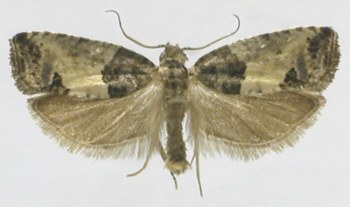Pests
Spilonota ocellana (Denis & Shiffermueller) - Eye-spotted Bud Moth
Systematic position.
Class Insecta, order Lepidoptera, family Tortricidae, subfamily Olethreutinae, tribe Eucosmini, genus Spilonota.Synonyms.
Tmetocera ocellana F.Biological group.
This is a polyphagous pest of rosaceous fruit trees and forest species.Morphology and biology.
Fore wings are yellowish-white in the middle third (wingspan is 14-18 mm). Pre-tornal spot occupies almost one third of wing, grayish-brown, with blue tint. Large tapetum located at outer margin, bordered by two shiny lead-colored stripes. External margin of wing is gray-black, fringe black. Hind wings are brown-gray. Eggs are oval, flattened, transparent and shiny. Caterpillars of 1st instar yellow-green or light yellow, later brown or grayish-brown. Pupa 7-10 mm, light brown with blunt rounded apex and 8 thin hooked apical setae. Average fertility of moths is 230 (87 to 400) eggs in wintered generation and 68-90 eggs in summer generation. Caterpillars of 2nd-5th instars winter under bud scales, under leaf residues drawn to branches, under bark scales in forks of branches. In spring they bite into buds. Then caterpillars gnaw through leaf petioles, flower and fruit pedicels, and braid the damaged buds, flowers and leaves into bunches. Pupation occurs in feeding places, among damaged leaves or in cracks of bark and in forks of branches. The pupal stage lasts 9-15 days. Female lays eggs one by one or in groups of 3-5 on the upper side, less often on the lower side of leaves, occasionally on fruits. Eggs develop in 8-12 days. Summer caterpillars develop in dark tubules of plaited excrements and silk threads on the lower side of leaves, feeding between plaited leaves, braiding them to the surface of fruits.Distribution.
This species is distributed throughout Western Europe (everywhere), Madiera, North Africa, Asia Minor, Iran, China, Pakistan, Japan, Korea, in North America. In the former USSR it is distributed in the European part (everywhere), Transcaucasia, Kazakhstan, in mountains of Turkmenistan, Uzbekistan, Tajikistan, in Siberia and the Far East.Ecology.
This species is monovoltine in the northern part of its area; 1.5-2 generations in Ukraine, Moldova, Transcaucasia, Central Asia, and in the south of Siberia. In mountains of Tajikistan the species is monovoltine at 2000 m above sea level and higher and bivoltine at 1800 m and lower. The wintered caterpillars renew feeding in April and the beginning of May, in Tadjikistan from the end of March, at average daily temperature 8°C, during the period of green tops and before balloon.s status of apple development. The period of pupation lasts from the beginning of May until the 2nd third of June or the middle of July (Azerbaijan). The pupal stage lasts 9-15 (13 on the average) days at temperatures of 15-20°C. Moths fly from the end of May until the beginning of August. Oviposition starts in the 1st or in the beginning of the 2nd third of June (Azerbaijan). Duration of egg development is 8-12 days at 20°C and relative air humidity 50%. In the south (Moldova, Crimea) the caterpillars partly pass aestivation over a month. Pupation occurs from the middle of July until the middle of August. Moths of the 2nd generation fly from the middle of August until the middle of September. Hatching of caterpillars begins in August. In the south of the area there is an overlay of terms of development of various stages of two different generations and a sharp increase of numbers of the caterpillars eating fruits in August - September because of summer aestivation of caterpillars. This results in a sharp decrease of apple and plum yields. In the zone of development of one generation the harmful activity of the species is not great.Economic significance.
This is a dangerous pest of young plantings of apple, pear, and plum. It also damages quince, cherry, apricot, almonds, cotoneaster, hawthorn, and bird cherry. In forests the caterpillars develop on practically all wild-growing rosaceous species, damaging sea-buckthorn berries, hazel, birch, willow, maple, alder, also found on sorrel and euphorbia. Apple yield losses can reach 15-50%, in Azerbaijan 75%. A similar level of harm has been found on pear in Tadjikistan. Destruction of 20% of buds and leaves has been locally found in Georgia.Control measures.
Agronomical measures include pruning old and diseased branches and the use of trapping bands. Biological measures include the application of biological preparations. Chemical measures include local insecticide treatments during development of over-wintered caterpillars before the flowering of trees (during the phase of red buds) in spring. Monitoring and forecast is possible with the use of pheromone traps.Reference citations:
Ermolaev V.P. 1988. Tortricidae. In: Kirpichnikova V.A., Ler P.A., eds. Butterflies - pests of agriculture in the Far East. Keys. Vladivostok: Biology and Soil Institute, DO AN SSSR. 65-99 p. (In Russian)Galetenko S.M. 1964. To morphology of fruit leafrollers. In: Kochkin M.A., Rubtsov N.I., Ryndin N.V., eds. 150 years to State Nikitskii botanical garden. Collection of scientific works. V. 37. Moscow: Kolos. 531-395 p. (In Russian)
Kostyuk Yu.A. 1974. Family Tortricidae. In: Vasil.ev V.P., ed. Pests of agricultural crops and forest plantations. V. 2. Arthropods. Kiev: Urozhai. 261-320 p. (In Russian)
Kuznetsov V.I. 1994. Family Tortricidae. In: Kuznetsov V.I., ed. Insects and mites - pests of agricultural plants. V. 3(1). Lepidoptera. St. Petersburg: Nauka. 51-234 p. (In Russian)
Savkovskii P.P. 1976. Atlas of the pests of fruit and berry plants. Kiev: Urozhai. 207 p. (In Russian)
Vasil.ev V.P., Livshits I.Z. 1984. Pests of fruit crops. Moscow: Kolos. 399 p. (In Russian)


